List of dynasties and rulers of Rajasthan
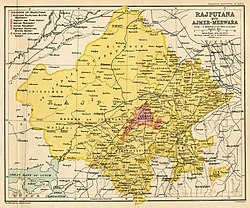
Rajasthan is a state in northern India. The History of Rajasthan is about 5000 years old. The history of Rajasthan can be classified into three parts owing to the different epochs- Ancient, Medieval and Modern. Rajput clans emerged and held their sway over different parts of Rajasthan from about 700 CE.
Rajputana “land of the Rajputs” was Rajasthan's old name under the British Raj. When India became independent, 23 princely states were consolidated to form the state of Rajasthan, “Home of Rajas”.
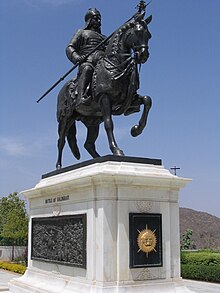
Following is a list of dynasties and rulers, which ruled or origin from Rajasthan from Ancient period to Modern period:
Pratihara dynasty (c. 550 – 1036 CE)
Pratiharas of Mandavyapura (Mandore) (c. 550 – 860 CE)
Rudolf Hoernlé assumed a period of 20 years for each generation, and placed the dynasty's founder Harichandra in c. 640 CE. Baij Nath Puri placed Harichandra in c. 600 CE. R. C. Majumdar, on the other hand, assumed a period of 25 years for each generation, and placed him in c. 550 CE.[1] The following is a list of the dynasty's rulers (IAST names in brackets) and estimates of their reigns, assuming a period of 25 years:[2]
- Harichandra (Haricandra) alias Rohilladhi (r. c. 550 CE)
- Rajilla (r. c. 575 CE)
- Narabhatta (Narabhaṭa) alias Pellapelli (r. c. 600 CE)
- Nagabhata (Nāgabhaṭa) alias Nahada (r. c. 625 CE)
- Tata (Tāta) and Bhoja (r. c. 650 CE)
- Yashovardhana (Yaśovardhana) (r. c. 675 CE)
- Chanduka (Canduka) (r. c. 700 CE)
- Shiluka (Śīluka) alias Silluka (r. c. 725 CE)
- Jhota (r. c. 750 CE)
- Bhilladitya alias Bhilluka (r. c. 775 CE)
- Kakka (r. c. 800 CE)
- Bauka (Bāuka) (r. c. 825 CE)
- Kakkuka (r. c. 861 CE)
Bauka and Kakkuka were sons of Kakka from different mothers. The Jodhpur and Ghantiyala inscriptions of the two step-brothers give same genealogy of the family, except the last two names. Since these two inscriptions were found not far from each other, it appears that Bauka succeeded Kakka (rather than the two dividing Kakka's kingdom).[3]
Pratiharas of Bhinmala and Kannauj (c. 730 – 1036 CE)
| Serial No. | Ruler | Reign (CE) |
|---|---|---|
| 1 | Nagabhata I | 730–760 |
| 2 | Kakustha and Devaraja | 760–780 |
| 3 | Vatsaraja | 780–800 |
| 4 | Nagabhata II | 800–833 |
| 5 | Ramabhadra | 833–836 |
| 6 | Mihira Bhoja or Bhoja I | 836–885 |
| 7 | Mahendrapala I | 885–910 |
| 8 | Bhoja II | 910–913 |
| 9 | Mahipala I | 913–944 |
| 10 | Mahendrapala II | 944–948 |
| 11 | Devapala | 948–954 |
| 12 | Vinayakapala | 954–955 |
| 13 | Mahipala II | 955–956 |
| 14 | Vijayapala II | 956–960 |
| 15 | Rajapala | 960–1018 |
| 16 | Trilochanapala | 1018–1027 |
| 17 | Yasahpala | 1024–1036 |
Mewar dynasty (c. 566 – 1948 CE)
Guhila dynasty of Nagada-Ahar is one of the oldest dynasties of Mewar, they ruled in the 6th century and Sisodia Dynasty (1326–1947 CE) is one of the branch of Guhila dynasty.
Guhila dynasty (c. 566 – 1303 CE)
| Serial No. | King (Rawal) | Reign (CE) | Notes |
|---|---|---|---|
| 1 | Rawal Guhil | 566–586 | |
| 2 | Rawal Bhoj | 586–606 | |
| 3 | Rawal Mahendra I | 606–626 | |
| 4 | Rawal Naga (Nagaditya) | 626–646 | |
| 5 | Rawal Shiladitya | 646–661 | |
| 6 | Rawal Aprajeet | 661–688 | |
| 7 | Rawal Mahendra II | 688–716 | |
| 8 | Bappa Rawal | 728–753 | |
| 9 | Rawal Khuman I | 753–773 | |
| 10 | Rawal Mattat | 773–793 | |
| 11 | Rawal Bhartri Bhatt I | 793–813 | |
| 12 | Rawal Sinh | 813–828 | |
| 13 | Rawal Khuman II | 828–853 | |
| 14 | Rawal Mahayak | 853–878 | |
| 15 | Rawal Khuman III | 878–926 | |
| 16 | Rawal Bhartri Bhatt II | 926–951 | |
| 17 | Rawal Allat | 951–971 | |
| 18 | Rawal Narwahan | 971–973 | |
| 19 | Rawal Saliwahan | 973–977 | |
| 20 | Rawal Shakti Kumar | 977–993 | |
| 21 | Rawal Amba Prasad | 993–1007 | |
| 22 | Rawal Shuchivarma | 1007–1021 | |
| 23 | Rawal Narvarma | 1021–1035 | |
| 24 | Rawal Keertivarma | 1035–1051 | |
| 25 | Rawal Yograj | 1051–1068 | |
| 26 | Rawal Vairath | 1068–1088 | |
| 27 | Rawal Hanspal | 1088–1103 | |
| 28 | Rawal Vair Singh | 1103–1107 | |
| 29 | Rawal Vijai Singh | 1107–1116 | |
| 30 | Rawal Ari Singh I | 1116–1138 | |
| 31 | Rawal Chaudh Singh | 1138–1148 | |
| 32 | Rawal Vikram Singh | 1148–1158 | |
| 33 | Rawal Rana Singh | 1158–1168 | |
| Post-split Rawal branch rulers | |||
| 34 | Rawal Khshem Singh(Karana) | 1168–1172 | |
| 35 | Rawal Samant Singh(Rahapa) | 1172–1179 | |
| 36 | Rawal Kumar Singh | 1179–1191 | |
| 37 | Rawal Mathan Singh | 1191–1211 | |
| 38 | Rawal Padam Singh | 1211–1213 | |
| 39 | Rawal Jaitra Singh | 1213–1252 | |
| 40 | Rawal Tej Singh | 1252–1273 | |
| 41 | Rawal Samar Singh | 1273–1302 | |
| 42 | Rawal Ratan Singh | 1302–1303 | |
Branching of Guhil dynasty
During reign of Rawal Rana Singh (1158–1168), the Guhil dynasty got divided into two branches:
- First (Rawal Branch)
Rawal Khshem Singh (1168–1172), son of Ran Singh, ruled over Mewar by building Rawal Branch.
- Second (Rana Branch)
Rahapa, the second son of Ran Singh started the Rana Branch by establishing Sisoda bases. Later Hammir Singh of Sisoda base started main Sisodia or Mewar dynasty in 1326 CE.
Rana branch rulers (c. 1168 – 1326 CE)
"Rahapa", a son of Ranasimha, established the Rana branch. According to the 1652 Eklingji inscription, Rahapa's successors were:
| Nu. | King (Rana) | Reign (CE) | Notes |
|---|---|---|---|
| 1 | Rahapa/Karna | 1168 CE | |
| 2 | Narapati | ||
| 3 | Dinakara | ||
| 4 | Jasakarna | ||
| 5 | Nagapala | ||
| 6 | Karnapala | ||
| 7 | Bhuvanasimha | ||
| 8 | Bhimasimha | ||
| 9 | Jayasimha | ||
| 10 | Lakhanasimha | ||
| 11 | Arisimha | ||
| 12 | Hammir Singh | 1326 CE |
Sisodia dynasty (c. 1326 – 1947 CE)
| Portrait | King (Maharana) | Reign | Notes |
|---|---|---|---|
| Hammir Singh | 1326–1364 | He attacked Chittor in 1326 and re-took it from the Khiljis after the family lost it in 1303. Defeated Muhammad Bin Tughluq in SSingoli taking the sultan himself a prisoner of war.
Captured Ajmer, Ranthambor, Nagaur and Sopore.[4] | |
| Kshetra Singh | 1364–1382 | Hammir's son, he captured Madalgarh and Bundi, completely annexed Ajmer. He also defeated Amin Shah of Malwa at the "Battle of Bakrole" and inflicted heavy casualties. His death can actually by as late as 1405.[5] | |
| Lakha Singh | 1382–1421 | Khsetra's son, he was defeated multiple battles by Zafar Khan of Gujrat, but the territories were recovered. He rebuilt temples and shrines destroyed by Allaudin Khilji.[6] | |

|
Mokal Singh | 1421–1433 | Lakha's son, he defeated the Sultan of Nagaur and Gujrat. Later the sultan of Gujrat invaded Mewar and during this invasion. He was assassinated by his uncles Chacha and Mera.[7] |
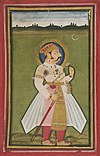
|
Rana Kumbha | 1433–1468 | Mokal's son, he first attacked and killed his fathers assassins. Defeated the Sultans of Nagaur, Gujarat and Malwa. Mewar became the strongest kingdom in North India. Built multiple strong forts in Mewar.[8] |
| Udai Singh I | 1468–1473 | Kumbha' son, he assassinated his father and was then defeated by his brother.[9] | |
| Rana Raimal | 1473–1508 | Son of Kumbha, he killed his brother for assassinating his father. Fought against Malwa sultanate.[10][11] | |
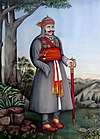
|
Rana Sanga | 1508–1527 | Raimal's son, defeated the Sultan of Gujrat, Malwa and Delhi. Under his rule Mewar reached its pinnacle in power and prosperity. Eventually defeated by Babur.[12][13] |
| Ratan Singh II | 1528–1531 | Sanga's son, defeated and killed by Bahadur Shah of Gujarat.[14] | |
| Vikramaditya Singh | 1531–1536 | Sanga's son, assassinated by his cousin Vanvir Singh.[15] | |
| Vanvir Singh | 1536–1540 | Usurper of the throne. Defeated and expelled by his cousin Udai Singh II.[16] | |

|
Udai Singh II | 1540–1572 | Sanga's son, defeated Vanvir. Fought against Mughals and was defeated in Siege of Chittorgarh.[17][18] |
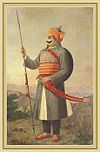
|
Maharana Pratap | 1572–1597 | Udai's son, notable for his military resistance against the Mughals.[19] |

|
Amar Singh I | 1597–1620 | Pratap's son, notable for his struggle against Mughals.[20] |
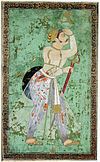
|
Karan Singh II | 1620–1628 | Amar's son, maintained good relations with Mughals, built many temples, forts and strengthened existing ones.[21] |
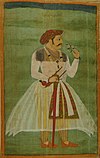
|
Jagat Singh I | 1628–1652 | Karan's son, attempted to restore fort of Chittor but Shah Jahan blocked his attempt. |

|
Raj Singh I | 1652–1680 | Jagat's son, fought and defeated Mughals many times. Regained territory and increased the wealth of the kingdom. Fought against Aurangzeb. Eventually poisoned by Aurangzeb's loyalists.[22][23][24] |
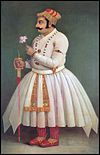
|
Jai Singh | 1680–1698 | Raj's son, struggled to regain captured parts of Mewar from Mughals.[25] |

|
Amar Singh II | 1698–1710 | Jai's son, invaded neighboring territories, formed an alliance against the Mughals with Jaipur and Marwar. Capitalized over a weak Mughal empire.[26] |

|
Sangram Singh II | 1710–1734 | Amar's son, defeated Ranabaaz Khan at the Battle of Bandanwara. Reestablished relations with a weak Mughal emperor. |
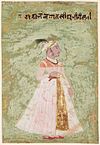
|
Jagat Singh II | 1734–1751 | Sangram's son, started paying Chauth to the Marathas. Heavily invested in placing Sawai Madho Singh on the throne of Jaipur, eventually bankrupting Mewar. |

|
Pratap Singh II | 1751–1754 | Jagat's son. |
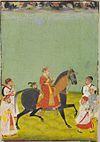
|
Raj Singh II | 1754–1762 | Pratap's son, paid heavy tribute to Maratha's, financially devastating Mewar. |

|
Ari Singh II | 1762–1772 | Raj's son, under him, Maratha's raided Mewar multiple times for not paying tribute. |
| Hamir Singh II | 1772–1778 | Ari's son, underaged when became Rana and died. | |

|
Bhim Singh | 1778–1828 | Hamir's brother, under him Mewar was repeatedly raided by Pindaris, Marwar and Jaipur fought for his daughter Krishna Kumari. Accepted sub ordinance of East India Company. |

|
Jawan Singh | 1828–1838 | Bhim's son, abused alcohol, not interested in ruling Mewar. Mewar racked up a lot of debt under his rule. |
| Sardar Singh | 1838–1842 | Jawan's son | |

|
Swarup Singh | 1842–1861 | Ruler during the Indian Rebellion of 1857. |

|
Shambhu Singh | 1861–1874 | Focused on reform of education and social reforms. |

|
Sajjan Singh | 1874–1884 | Shambhu's ruler. |
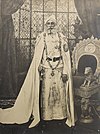
|
Fateh Singh | 1884–1930 | Sajjan's son |
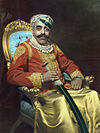
|
Bhupal Singh | 1930–1948 1948–1955 (titular) |
Signed the Instrument of Accession to India, dissolving his kingdom into the India. Titular ruler from 1955 |
| Titular Maharanas | |||

|
Bhagwat Singh | 1955–1984 | Lost the Privy Purse. |

|
Mahendra Singh | 1984–2024 | Bhagwat's elder son |
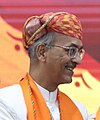
|
Vishvaraj Singh | 2024–present | Present ruler |
Chauhan dynasty (c. 551 – 1315 CE)
Chauhans originally known as Chahamanas is the Rajput dynasty. The earliest Chauhan dynasty was Chahamanas of Shakambhari that ruled territory known as Sambhar.
- The ruling dynasties belonging to the Chauhan clan included
- Chahamanas of Shakambhari (Chauhans of Ajmer) (c. 551 – 1194 CE)
- Chahamanas of Naddula (Chauhans of Nadol) (c. 950 – 1197 CE)
- Chahamanas of Jalor (c. 1160 – 1311 CE), branched off from the Chahamanas of Naddula
- Chahamanas of Ranastambhapura (c. 1192 – 1301 CE), branched off from the Chahamanas of Shakambhari
- Chahamanas of Chandravati and Abu (Kingdom of Sirohi) (c. 1311 – 1949 CE)
- Chahamanas of Lata
- Chahamanas of Dholpur
- Chahamanas of Partabgarh
- Hada Chauhan kingdoms of Hadoti region are–
- Kingdom of Bundi (c. 1342 – 1949 CE)
- Kingdom of Kota (c. 1579 – 1948 CE)
- Kingdom of Jhalawar (c. 1838 – 1949 CE), branched off from the Kingdom of Kota in 1838 CE.
Chahamanas of Sambhar, Ajmer and Delhi (c. 551 – 1194 CE)
Following is a list of Chahamana rulers of Shakambhari, Ajmer and Delhi with approximate period of reign, as estimated historian by R. B. Singh:[27]
| Serial no. | Regnal names | Reign (CE) | Notes |
|---|---|---|---|
| 1 | King Chahamana | (Unknown) | Ancient founder of Chahamana clan. |
| 2 | Vasu-deva | c. 551 CE (disputed) | First known ruler of the dynasty. He ruled the Sapadalaksha region and made Shakambhari (modern Sambhar) as capital. |
| 3 | Samanta-raja | 684–709 | Identified as the ancient King Manik Rai by R. B. Singh. |
| 4 | Nara-deva | 709–721 | Naradeva was succeeded by his brother Ajayaraja I. |
| 5 | Ajaya-raja I | 721–734 | According to Prithviraja Vijaya, he was a great warrior who defeated several enemies. |
| 6 | Vigraha-raja I | 734–759 | He achieved military successes upon neighbouring kingdom. |
| 7 | Chandra-raja I | 759–771 | Chandraraja I was a son of the Chahamana king Vigraharaja I. He was succeeded by his brother Gopendraraja. |
| 8 | Gopendra-raja | 771–784 | The Prabandha-Kosha states that Gopendra defeated Arab invader Muhammad bin Qasim in a battle. |
| 9 | Durlabha-raja I | 784–809 | He achieved military success against the Pala Empire king Dharmapala as a vassal of the Pratihara emperor Vatsaraja. |
| 10 | Govinda-raja I alias Guvaka I | 809–836 | The Harsha stone inscription suggests that he was a vassal the Pratihara emperor Nagabhata II. |
| 11 | Chandra-raja II | 836–863 | He was succeeded by his son Govindaraja II. |
| 12 | Govindaraja II alias Guvaka II | 863–890 | The Harsha stone inscription describes Govinda II as a warrior. He married his sister to Pratihara emperor Mihira Bhoja. |
| 13 | Chandana-raja | 890–917 | According to the Harsha stone inscription, Chandana defeated a Tomara ruler named Rudra
(Chandrapala). |
| 14 | Vakpati-raja | 917–944 | His younger son established the Naddula Chahamana branch in 950 CE. |
| 15 | Simha-raja | 944–971 | He was the first independent ruler of dynasty. He had assume the title of Maharajadhiraja. |
| 16 | Vigraha-raja II | 971–998 | He joined an alliance formed by the ruler of Lahore against the Ghaznavid ruler Sabuktigin. |
| 17 | Durlabha-raja II | 998–1012 | He assumed the title Maharajadhiraja. He joined a confederacy of Hindu kings to support Anandapala in
Battle of Chach against invasion Mahmud of Ghazni in 1008 CE. |
| 18 | Govinda-raja III | 1012–1026 | The Prabandha Kosha states that he defeated Mahmud of Ghazni badly. |
| 19 | Vakpati-raja II | 1026–1040 | Later texts claimed that he defeated Bhoja, the Paramara king of Malwa. |
| 20 | Viryarama | 1040 (few months) | Paramara king Bhoja attacked Chahamana kingdom and defeated him. |
| 21 | Chamunda-raja | 1040–1065 | He have defeated a Muslim army led by a Ghaznavid Sultan or general. |
| 22 | Durlabha-raja III alias Duśala | 1065–1070 | He conquered military successes upon neighbouring kingdom. |
| 23 | Vigraha-raja III alias Visala | 1070–1090 | He defeated Shahab-ud-Din (general of Ibrahim of Ghazna). |
| 24 | Prithvi-raja I | 1090–1110 | After defeating Muslim invaders he adopted titles as Parama-bhattaraka Maharajadhiraja Parameshvara. |
| 25 | Ajaya-raja II | 1110–1135 | He founded the city of Ajmer and moved his capital there. |
| 26 | Arno-raja alias Ana | 1135–1150 | His title as Maharajadhiraja-Parameshvara. |
| 27 | Jagad-deva | 1150 | Some sources claimed that he ascended Chahamana throne after killing his father. |
| 28 | Vigraha-raja IV alias Visaladeva | 1150–1164 | The Chahaman kingdom reached its zenith under him. |
| 29 | Apara-gangeya | 1164–1165 | He have ascended the throne as a minor, and ruled for a very short period. |
| 30 | Prithvi-raja II | 1165–1169 | He probably died heirless, so he was succeeded by his uncle Someshvara. |
| 31 | Someshvara | 1169–1178 | He adopted title of Pratāpalaṃkeśvara. |
| 32 | Prithviraja III Rai Pithora | 1177–1192 | Last effective ruler of the dynasty who was defeated in the Second Battle of Tarain against Muhammad of Ghor in 1192 CE. |
| 33 | Govinda-raja IV | 1192 | Ghurid vassal who later established the Chahamana branch of Ranastambhapura in 1192 CE. |
| 34 | Hari-raja | 1193–1194 | Last ruler of Chauhan dynasty branch of Ajmer. |
Chahamanas of Naddula (c. 950 – 1197 CE)
Following is a list of Chahmana rulers of Naddula, with approximate period of reign, as estimated by R. B. Singh:
| Serial no. | Kings | Reign (CE) |
|---|---|---|
| 1 | Lakshmana | 950–982 |
| 2 | Shobhita | 982–986 |
| 3 | Baliraja | 986–990 |
| 4 | Vigrahapala | 990–994 |
| 5 | Mahindra | 994–1015 |
| 6 | Ashvapala | 1015–1019 |
| 7 | Ahila | 1019–1024 |
| 8 | Anahilla | 1024–1055 |
| 9 | Balaprasada | 1055–1070 |
| 10 | Jendraraja | 1070–1080 |
| 11 | Prithvipala | 1080–1090 |
| 12 | Jojalladeva | 1090–1110 |
| 13 | Asharaja | 1110–1119 |
| 14 | Ratnapala | 1119–1132 |
| 15 | Rayapala | 1132–1145 |
| 16 | Katukaraja | 1145–1148 |
| 17 | Alhanadeva | 1148–1163 |
| 18 | Kelhanadeva | 1163–1193 |
| 19 | Jayatasimha | 1193–1197 |
Chahamanas of Jalor (c. 1160 – 1311 CE)
The Chahamana rulers of the Jalor branch, with their estimated periods of reign, are as follows:[28]
Virama-deva (1311 CE) was last ruler of dynasty, crowned during the Siege of Jalore, but died 21⁄2 days later.[29][30]
| Serial no. | Kings | Reign (CE) |
|---|---|---|
| 1 | Kirti-pala | 1160–1182 |
| 2 | Samara-simha | 1182–1204 |
| 3 | Udaya-simha | 1204–1257 |
| 4 | Chachiga-deva | 1257–1282 |
| 5 | Samanta-simha | 1282–1305 |
| 6 | Kanhada-deva | 1292–1311 |
| 7 | Virama-deva | 1311 |
Chahamanas of Ranastambhapura (c. 1192 – 1301 CE)
| Serial no. | Kings | Reign (CE) |
|---|---|---|
| 1 | Govinda-raja | 1192 |
| 2 | Balhana-deva | |
| 3 | Prahlada-deva | |
| 4 | Viranarayana | |
| 5 | Vagabhata | |
| 6 | Jaitra-simha | |
| 7 | Shakti-deva | |
| 8 | Hammira-deva | 1283–1311 |
Kachwaha dynasty (c. 966 – 1949 CE)
Kachwahas king Sorha Dev and Dulha Rao defeated Meena of Dhundhar kingdom between 950 and 966 CE and established Kingdom of Amber.[31]
- List of Kachwaha rulers of Dhoondar
- 27 Dec 966 – 15 Dec 1006 Sorha Dev (d. 1006)
- 15 Dec 1006 – 28 Nov 1036 Dulha Rao (d. 1036)
- 28 Nov 1036 – 20 Apr 1039 Kakil (d. 1039)
- 21 Apr 1039 – 28 Oct 1053 Hanu (d. 1053)
- 28 Oct 1053 – 21 Mar 1070 Janddeo (d. 1070)
- 22 Mar 1070 – 20 May 1094 Pajjun Rai (d. 1094)
- 20 May 1094 – 15 Feb 1146 Malayasi (d. 1146)
- 15 Feb 1146 – 25 Jul 1179 Vijaldeo (d. 1179)
- 25 Jul 1179 – 16 Dec 1216 Rajdeo (d. 1216)
- 16 Dec 1216 – 18 Oct 1276 Kilhan (d. 1276)
- 18 Oct 1276 – 23 Jan 1317 Kuntal (d. 1317)
- 23 Jan 1317 – 6 Nov 1366 Jonsi (d. 1366)
- 6 Nov 1366 – 11 Feb 1388 Udaikarn (d. 1388)
- 11 Feb 1388 – 16 Aug 1428 Narsingh (d. 1428)
- 16 Aug 1428 – 20 Sep 1439 Banbir (d. 1439)
- 20 Sep 1439 – 10 Dec 1467 Udharn (d. 1467)
- 10 Dec 1467 – 17 Jan 1503 Chandrasen (d. 1503)
- 17 Jan 1503 – 4 Nov 1527 Prithviraj Singh I (d. 1527)[32]
- 5 Nov 1527 – 19 Jan 1534 Puranmal (d. 1534)[33]
- 19 Jan 1534 – 22 Jul 1537 Bhim Singh (d. 1537)
- 22 Jul 1537 – 15 May 1548 Ratan Singh (d. 1548)
- 15 May 1548 – 1 June 1548 Askaran (d. 1599)
- 1 Jun 1548 – 27 Jan 1574 Bharmal (d. 1574)
- 27 Jan 1574 – 4 Dec 1589 Bhagwant Das (b. 1527 – d. 1589)
- 4 Dec 1589 – 6 Jul 1614 Man Singh (b. 1550 – d. 1614)
- 6 Jul 1614 – 13 Dec 1621 Bhau Singh (d. 1621)
- 13 Dec 1621 – 28 Aug 1667 Jai Singh I (b. 1611 – d. 1667)
- 10 Sep 1667 – 30 Apr 1688: Ram Singh I (b. 1640 – d. 1688)
- 30 Apr 1688 – 19 Dec 1699: Bishan Singh (b. 1672 – d. 1699)
- 19 Dec 1699 – 21 Sep 1743: Jai Singh II (b. 1688 – d. 1743)
- 1743 – 12 Dec 1750: Ishwari Singh (b. 1721 – d. 1750)
- Dec 1750 – 6 Mar 1768: Madho Singh I (b. 1728 – d. 1768)[34]
- 7 Mar 1768 – 16 Apr 1778: Prithvi Singh II[35]
- 1778 – 1803: Pratap Singh (b. 1764 – d. 1803)
- 1803 – 21 Nov 1818: Jagat Singh II (b. ... – d. 1818)
- 22 Dec 1818 – 25 Apr 1819: Mohan Singh (regent) (b. 1809 – d. ...)
- 25 Apr 1819 – 6 Feb 1835: Jai Singh III (b. 1819 – d. 1835)
- Feb 1835 – 18 Sep 1880: Ram Singh II (b. 1835 – d. 1880)
- 18 Sep 1880 – 7 Sep 1922: Madho Singh II (b. 1861 – d. 1922)
- 7 Sep 1922 – 15 Aug 1947 (subsidiary): Sawai Man Singh II (b. 1912 – d. 1970)
- 15 Aug 1947 – 7 Apr 1949 (independent): Sawai Man Singh II (b. 1912 – d. 1970)
He was the last ruler of Kachawa dynasty, he annexed Jaipur State with Union of India in 1949 CE.[36][37]
- Titular rulers
- 7 Apr 1949 – 24 Jun 1970: Sawai Man Singh II
- 24 Jun 1970 – 28 Dec 1971: Sawai Bhawani Singh (b. 1931 – d. 2011)
Titles were abolished in 1971 according to the 26th amendment to the Indian Constitution.
- 28 Dec 1971 – 17 Apr 2011: Sawai Bhawani Singh (b. 1931 – d. 2011)
- 17 Apr 2011 – present: Padmanabh Singh (b. 1998)
Bhati dynasty (c. 600 – 1949 CE)
Bhati dynasty ruled present Jaisalmer from 600s CE.
- Early rulers
- Jaisimha, while the genealogy of the Bhatti Rajputs is known, it does seem to be approximate, and is poorly dated. Only a few names stand out and can be linked to historical events, and not reliably so until the 12th century.
- Bahubal
- Subahu
- Rajh
- Gaj
- Salivahan
- Baland
- Bhati
- Mangal Rao
- Majam Rao
- Kehar / Ehar I (773–806)
- Tano (806–821)
- Bijairai I (821–853)
- Deoraj / Devraj (853–908)
- Mund / Mundh (908–979)
- Bachharajat / Bijairaj II (979–1044)
- Dusaj (1044–1124)
- Lanja
- Bhojdev / Bhojdeo
- Rawals
- Rawal Jaisal Singh (1153–1168), official founder of kingdom, early Bhatti capital at Lodorva (Ludarva) is ransacked and laid waste Muhammad of Ghor. Nevertheless, he and Jaisal patch up their differences and Jaisal goes on to kill his own brother and nephew in battle with the help of Muhammad Ghor A new capital is established when Jaisal founds the city of Jaisalmer.
- Rawal Shalivahan Singh II (1168–1200)
- Rawal Baijal Singh (1200–1200)
- Rawal Kailan Singh (1200–1219)
- Rawal Chachak Deo Singh (1219–1241)
- Rawal Karan Singh I (1241–1271)
- Rawal Lakhan Sen (1271–1275)
- Rawal Punpal Singh (1275–1276)
- Rawal Jaitsi Singh I Rawal Jethsi (1276–1294), the Bhati Rajput leader Jethsi faces an eight-year siege by Sultan Aladin Khilji of Delhi. Tradition has it that when the Bhatti Rajputs are sure of their impending defeat, they kill their womenfolk, with some committing 'Jauhar' by jumping into the fire lest they be defiled by the enemy. The males, the warriors, march from the fort, heading straight for their enemy and a final massacre. Eventually some surviving Bhattis reoccupy the fort.
- Rawal Mulraj Singh I (1294–1295)
- Rawal Durjan Sal (Duda) (1295–1306), The second Jauhar takes place under similar circumstances, this time against Sultan Ferozshah of Delhi.
- Rawal Gharsi Singh (1306–1335)
- Rawal Kehar Singh II (1335–1402)
- Rawal Lachhman Singh (1402–1436)
- Rawal Bersi Singh (1436–1448)
- Rawal Chachak Deo Singh II (1448–1457)
- Rawal Devidas Singh (1457–1497)
- Rawal Jaitsi Singh II (1497–1530)
- Rawal Karan Singh II (1530–1530)
- Rawal Lunkaran Singh (1530–1551), the third Jauhar takes place when a local Afghan chief by the name of Amir Ali attacks Jaisalmer, one of many Afghans settled in north-western India. This time around the army of Jaisalmer is victorious in its defence. Lunakaran also fights Moghul emperor, Humayun as the emperor passes through on his way to Ajmer.
- Rawal Maldev Singh (1551–1562)
- Rawal Harraj Singh (1562–1578), the Moghul king Akbar gains the submission of Jaisalmer, along with the other Rajputs of Bikaner, Bundi, and Jodhpur
- Rawal Bhim Singh (1578–1624), Bhim Singh forms a matrimonial alliance with the Moghuls when he marries his daughter to Raja Raj Singh of Bikaner. The raja's own daughter is married to Prince Salim, son of Akbar (later to be the Emperor Jehangir).
- Rawal Kalyan Singh (1624–1634)
- Rawal Manohar Das Singh (1634–1648)
- Rawal Ram-Chandra Singh (1648–1651)
- Rawal Sabal Singh (1651–1661), Sahal Singh assists Moghul Emperor Shah Jahan in his Peshawar campaign. He also extends his kingdom and comes into conflict with the Bikaner Rathors.
- Maharawals
- Maharawal Amar Singh of Jaisalmer (1661–1702)
- Maharawal Jaswant Singh of Jaisalmer (1702–1708)
- Maharawal Budh Singh (1708–1722)
- Maharawal Akhi Singh (1722–1762)
- Maharawal Mulraj II (1762–1820), attacks by the Jodhpur Rathors begin during the reign of Mulraj Singh II. Mulraj Singh signs a treaty with the British for protection.
- Maharawal Gaj Singh (1820–1846)
- Maharawal Ranjit Singh of Jaisalmer (1846–1864)
- Maharawal Bairi Sal (1864–1891)
- Maharawal Shalivahan Singh III (1891 –1914)
- Maharawal Jawahir Singh (1914–1947)
- Girdhar Singh (1949–1950), last ruler of kingdom merge state with Rajasthan Union in 1949.
- Titular kings
- Raghunath Singh (1950–1982)
- Brijraj Singh (1982–2020)
- Chaitanya Raj Singh (2020–present)
Jadaun dynasty (c. – 1947 CE)
Jadaun dynasty ruled over Karauli.
Rathore dynasty of Marwar (c. 1226 – 1950 CE)
Rathore rulers of Pali and Mandore (c. 1226 – 1438 CE)
- Rulers-
| Name | Notes | Reign began | Reign ended | |
|---|---|---|---|---|
| 1 | Rao Siha | He conquered Pali and became the first rao of the Rathore dynasty in Marwar. He died in the battle of Lakha Jhawar (1273) against Sultan Ghaus ud-din Balban. | 1226 | 1273 |
| 2 | Rao Asthan | Conquered Kher from the Gohils and Idar from the Bhils. He died in battle against Jalaludin Khilji. | 1273 | 1292 |
| 3 | Rao Doohad | He conquered more than 140 villages. He was killed in battle against the Parihars. | 1292 | 1309 |
| 4 | Rao Raipal | He avenged his father by killing the ruler of the Parihars. During a famine in Marwar he distributed his own personal grains to the people. | 1309 | 1313 |
| 5 | Rao Kanhapal | He suffered raids from the Turko-Afgan tribes and was killed in action defending his lands. | 1313 | 1323 |
| 6 | Rao Jalansi | He defeated the Sodhas. He took the turban of the Sodha chief to mark his supremacy in the region. | 1323 | 1328 |
| 7 | Rao Chado | 1328 | 1344 | |
| 8 | Rao Tida | He was killed in battle against the sultan of Delhi. | 1344 | 1357 |
| 9 | Rao Kanha Dev | 1357 | 1374 | |
| 10 | Rao Viram Dev | He died in battle against the Johiyas. | 1374 | 1383 |
| 11 | Rao Chandra | He conquered Mandore from the Turks in 1406. He further conquered the areas of Nagaur, Sambhar, Khatu, Nadol and Ajmer. He was killed in battle against Salim Shah of Multhan. | 1383 | 1424 |
| 12 | Rao Kanha | Fought battles with his brothers. Died young in Mandore. | 1424 | 1427 |
| 13 | Rao Ranmal | He consolidated his rule with the help of the Sisodias of Mewar. He was later assassinated on the orders of Rana Kumbha. | 1427 | 1438 |
Rathore rulers of Jodhpur (c. 1459 – 1950 CE)
- Rulers-
| Name | Notes | Reign began | Reign ended | |
|---|---|---|---|---|
| 1 | Rao Jodha | Fought Rana Kumbha and reclaimed his lands. He later founded the city of Jodhpur and made it his capital. He subjugated the states of Jalore and Bundi and annexed Ajmer, Sambhar and Mohilavati. | 12 May 1438 | 6 April 1489 |
| 2 | Rao Satal | Died from wounds after saving 140 women from Afghan raiders. | 6 April 1489 | March 1492 |
| 3 | Rao Suja | March 1492 | 2 October 1515 | |
| 4 | Rao Biram Singh | Son of Bagha | 2 October 1515 | 8 November 1515 |
| 5 | Rao Ganga | Assisted Rana Sanga in his campaigns against the Sultans of India. | 8 November 1515 | 9 May 1532 |
| 6 | Rao Maldeo | Successfully repelled the invasions of Sher Shah Suri. Called as one of the most potent rulers of Hindustan by Ferishta. | 9 May 1532 | 7 November 1562 |
| 7 | Rao Chandra Sen | He defended his kingdom for nearly two decades against relentless attacks from the Mughal Empire. | 7 November 1562 | 1581 |
| 8 | Raja Udai Singh Mota Raja | He was the father in law of Jahangir and got married his daughter Mani Bai married to him, later on who became parents of Shah Jahan[38] | 4 August 1583 | 11 July 1595 |
| 9 | Sawai Raja Suraj-Mal | 11 July 1595 | 7 September 1619 | |
| 10 | Maharaja Gaj Singh I | The first to take the title Maharaja by himself | 7 September 1619 | 6 May 1638 |
| 11 | Maharaja Jaswant Singh | He fought Aurangzeb in the Battle of Dharmatpur. | 6 May 1638 | 28 December 1678 |
| 12 | Maharaja Ajit Singh | Became Maharaja of Marwar after 25 years of war with Aurangzeb. Durgadas Rathore played a key role in the war. | 19 February 1679 | 24 June 1724 |
| 13 | Raja Indra Singh | Installed in opposition to Maharaja Ajit Singh by Emperor Aurangzeb but unpopular with people of Marwar | 9 June 1679 | 4 August 1679 |
| 14 | Maharaja Abhai Singh | Defeated Sarbuland Khan and occupied all of Gujarat for a short time. | 24 June 1724 | 18 June 1749 |
| 15 | Maharaja Ram Singh | First reign | 18 June 1749 | July 1751 |
| 16 | Maharaja Bakht Singh | He was the general of the Marwari forces against Sarbuland Khan and defeated him. In the Battle of Gangwana he defeated a combined army of Mughals and Kachwahas. | July 1751 | 21 September 1752 |
| 17 | Maharaja Vijay Singh | First reign | 21 September 1752 | 31 January 1753 |
| 18 | Maharaja Ram Singh | Second reign | 31 January 1753 | September 1772 |
| 19 | Maharaja Vijay Singh | Second reign – Was defeated by Mahadji Scindia and forced to surrender the fort and city of Ajmer. | September 1772 | 17 July 1793 |
| 20 | Maharaja Bhim Singh | 17 July 1793 | 19 October 1803 | |
| 21 | Maharaja Man Singh | Entered into treaty relations with the British on 6 January 1818. | 19 October 1803 | 4 September 1843 |
| 22 | Maharaja Sir Takht Singh | Not in the direct line, but a great-great-great-grandson of Ajit Singh. Formerly Regent of Ahmednagar. | 4 September 1843 | 13 February 1873 |
| 23 | Maharaja Sir Jaswant Singh II | Kaisar-i-Hind | 13 February 1873 | 11 October 1895 |
| 24 | Maharaja Sir Sardar Singh | Colonel in the British Indian Army | 11 October 1895 | 20 March 1911 |
| 25 | Maharaja Sir Sumair Singh | Colonel in the British Indian Army | 20 March 1911 | 3 October 1918 |
| 26 | Maharaja Sir Umaid Singh | Lieutenant-General in the British Indian Army | 3 October 1918 | 9 June 1947 |
| 27 | Maharaja Sir Hanwant Singh | Ruler of Marwar (Jodhpur) until accession to the Union of India in 1949; died on 26 January 1952 | 9 June 1947 | 7 April 1949 |
| 28 | (titular) Maharaja Gaj Singh II of Jodhpur | Became head of the House on 26 January 1952 | 26 January 1952 | Present |
Rathore dynasty of Bikaner (c. 1465 – 1947 CE)
- Rulers–
| Name | Reign Began (in CE) | Reign Ended (in CE) | Notes | |
|---|---|---|---|---|
| 1 | Rao Bika | 1465 | 1504 | First ruler of dynasty and founder of Bikaner city. |
| 2 | Rao Narayan Singh | 1504 | 1505 | |
| 3 | Rao Luna Karana (Lon-Karan) | 1505 | 1526 | |
| 4 | Rao Jait Singh (Jetasi) | 1526 | 1542 | |
| 5 | Rao Kalyan Mal | 1542 | 1574 | Acknowledged the suzerainty of Emperor Akbar at Nagaur in November 1570 |
| 6 | Rao Rai Singh I (Rai Rai Singh) | 1574 | 1612 | Important general in the Mughal army like Raja Man Singh I of Amber |
| 7 | Rai Dalpat Singh (Dalip) | 1612 | 1613 | |
| 8 | Rai Surat Singh Bhuratiya | 1613 | 1631 | |
| 9 | Rao Karan Singh (Jangalpat Badhshah) | 1631 | 1667 | Deposed by Emperor Aurangzeb for dereliction of duty at Attock, 11 January 1667. Exiled to his betel gardens at Karanpura in the Deccan. |
| 10 | Anup Singh | 1669 | 1698 | To be the first to be granted the title "Maharaja" by Emperor Aurangzeb. Served in the Deccan campaign at Salher in 1672, Bijapur in 1675, and the siege of Golconda in 1687. He was administrator of Aurangabad from 1677 to 1678, 'Hakim' of Adoni in 1678, Imtiazgarh and Adoni from 1689 to 1693, and of Nusratabad and Sukkar from 1693 to 1698 CE. |
| 11 | Rao Sarup Singh | 1698 | 1700 | He died from smallpox at Adoni in the Deccan on 15 December 1700. |
| 12 | Rao Sujan Singh | 1700 | 1735 | Ordered to attend Emperor Aurangzeb in the Deccan, where he remained for ten years. Faced invasions from Maharaja Abhai Singh of Jodhpur and Maharaja Bakht Singh of Nagaur, but successfully repulsed both. |
| 13 | Rao Zorawar Singh | 1735 | 1746 | |
| 14 | Rao Gaj Singh | 1746 | 1787 | The first of his line granted permission to mint his own coinage by Emperor Alamgir II. |
| 15 | Rao Rai Singh II (Raj Singh) | 1787 | 1787 | |
| 16 | Rao Pratap Singh | 1787 | 1787 | Reigned under the Regency of his uncle Surat Singh who poisoned him to assume the throne. |
| 17 | Rao Surat Singh | 1787 | 1828 | He incurred huge debts due to his military adventures which had reduced his state to near anarchy. Entered the protection of the East India Company with a subsidiary alliance on 9 March 1818. |
| 18 | Rao Ratan Singh | 1828 | 1851 | Received the hereditary title of Narendra Maharaja from Emperor Akbar Shah II and assisted the British by furnishing them with supplies during the First Afghan War of 1841. |
| 19 | Rao Sardar Singh | 1851 | 1872 | Assisted the British during the Indian Uprising of 1857 and served in person during many of the battles. Removed the name of the Mughal Emperor from his coinage, replacing the words with Aurang Arya Hind wa Queen Victoria. |
| 20 | Dungar Singh | 1872 | 1887 | Assisted the British during the Second Afghan War. |
| 21 | Ganga Singh | 1887 | 1943 | Member of Parliament (Lok Sabha) for Bikaner, 1952–1977. On 28 December 1971, India amended its Constitution to remove the position of the rulers of princely states and their right to receive privy-purse payments, thus making him the last ruler of Bikaner. Imperial Conferences and at the League of Nations. |
| 22 | Sadul Singh | 1943 | 1947 | Signed the Instrument of Accession to the Dominion of India on 7 August 1947. Merged his state into the present state of Rajasthan, India on 30 March 1949. |
| 23 | Karni Singh | 1947 | 1971 | First titular ruler. |
Sinsinwar Jat dynasty (c. 1683 – 1947 CE)
- Rulers-
| Ruler | Years |
|---|---|
| Raja Ram Sinsinwar | 1683–1688 |
| Churaman | 1695–1721 |
| Muhkam Singh | 1721–1722 |
| Badan Singh | 1722–1755 |
| Suraj Mal | 1755–1763 |
| Jawahar Singh | 1764–1768 |
| Ratan Singh | 1768–1769 |
| Kehri Singh | 1769–1778 |
| Ranjit Singh | 1778–1805 |
| Randhir Singh | 1805–1823 |
| Baldeo Singh | 1823–1825 |
| Balwant Singh | 1825–1853 |
| Jaswant Singh | 1853–1893 |
| Ram Singh | 1893–1900 |
| Kishan Singh | 1918–1929 |
| Brijendra Singh | 1929–1947 |
Gaur dynasty (c. 550 -1947)
- Gaur dynasty belong to the Surya vansh , they are descendants of the Maharaj Bharat(brother of lord ra), they ruled many parts of Rajasthan namely:- Sarwar, Fatehgarh, Ajmer, Junia, Kishangarh, whole gorwar region was named due to glory of this dynasty.
Jhala dynasty of Jhalawar (c. 1838-1949)
| Serial No. | Maharaj-Rana | Reign (CE) | Notes |
|---|---|---|---|
| 1 | Maharaj Rana Madan Singh | 8 Apr 1838 – 1845 | |
| 2 | Maharaj Rana Prithvi Singh | 1845 – 29 Aug 1875 | |
| 3 | Maharaj Rana Zalim Singh II | 29 Aug 1875 – 1 Jan 1899 | |
| 4 | HH Maharaj Rana Sir Bhawani Singh | 1 Jan 1899 – 13 Apr 1929 | |
| 5 | HH Maharaj Rana Sir Rajendra Singh | 13 Apr 1929 - 2 Sep 1943 | |
| 6 | HH Maharaj Rana Sir Harish Chandra Singh | 2 Sep 1943 – 15 Aug 1947 |
See also
- Rajasthan
- History of Rajasthan
- Outline of Rajasthan
- List of Rajput dynasties
- List of battles of Rajasthan
- Timeline of history of Rajasthan
References
- ^ Puri 1957, p. 23.
- ^ Mishra 1966, p. 3.
- ^ Puri 1957, p. 19.
- ^ Somani 1976, pp. 105–107.
- ^ Somani 1976, pp. 109–111.
- ^ Somani 1976, pp. 112–113.
- ^ Somani 1976, pp. 117–119.
- ^ Somani 1976, pp. 122–144.
- ^ Somani 1976, pp. 146–147.
- ^ Somani 1976, pp. 146–148.
- ^ Somani 1976, pp. 151–153.
- ^ Somani 1976, pp. 152–169.
- ^ "Maharana Sanga; the Hindupat, the last great leader of the Rajput race: Sarda, Har Bilas, Diwan Bahadur, 1867–1955 : Free Download, Borrow, and Streaming". Internet Archive. Retrieved 16 August 2020.
- ^ Somani 1976, pp. 171–181.
- ^ Somani 1976, pp. 189.
- ^ Somani 1976, pp. 189–193.
- ^ Somani 1976, pp. 193.
- ^ Somani 1976, pp. 208–215.
- ^ Somani 1976, pp. 220–230.
- ^ Somani 1976, pp. 253–259.
- ^ Somani 1976, pp. 260.
- ^ Sharma, Gopinath. Rajasthan Ka Itihas. Agra. p. 278. ISBN 978-81-930093-9-0.
- ^ Hooja, Rima (1 November 2006). A history of Rajasthan. Rupa & Co. p. 617. ISBN 9788129108906.
- ^ Somani 1976, pp. 281–282.
- ^ Sen, Sailendra (2013). A Textbook of Medieval Indian History. Primus Books. p. 183. ISBN 978-9-38060-734-4.
- ^ Somani 1976, pp. 315.
- ^ R. B. Singh (1964). History of the Chāhamānas. N. Kishore. pp. 51–70.
- ^ Ashok Kumar Srivastava (1979). The Chahamanas of Jalor. Sahitya Sansar Prakashan. p. xvi. OCLC 12737199.
- ^ Dasharatha Sharma (1959). Early Chauhān Dynasties. S. Chand / Motilal Banarsidass. p. 169. ISBN 978-0-8426-0618-9.
- ^ Ashok Kumar Srivastava 1979, p. 53.
- ^ Prasad, Rajiva Nain (1966). Raja Man Singh of Amber. pp. 1.
- ^ Sarkar, Jadunath (1994) [1984]. A History of Jaipur: C. 1503–1938. Orient Longman. p. 31. ISBN 81-250-0333-9.
- ^ Sarkar (1994, p. 33)
- ^ Sarkar (1994, p. 259)
- ^ Sarkar (1994, p. 260)
- ^ Arms & Armour at the Jaipur court by Robert Elgood p.10
- ^ Prasad (1966, pp. 1–3)
- ^ Jodhpur's Umaid Bhawan: The Maharaja of Palaces, by Aman Nath. Published by India Book House, 2008.
- ^ Niyogi, Roma (1959). The History of the Gāhaḍavāla Dynasty. Oriental. p. 30. OCLC 5386449.
Sources
- Mishra, Vibhuti Bhushan (1966). The Gurjara-Pratīhāras and Their Times. S. Chand. OCLC 3948567.
- Puri, Baij Nath (1957). The history of the Gurjara-Pratihāras. Munshiram Manoharlal. OCLC 2491084.
- Somani, Ram Vallabh (1976). History of Mewar, from Earliest Times to 1751 A.D. Mateshwari. OCLC 2929852.
